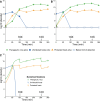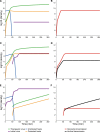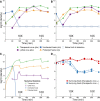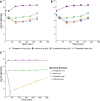Virus wars: using one virus to block the spread of another
- PMID: 27413636
- PMCID: PMC4933091
- DOI: 10.7717/peerj.2166
Virus wars: using one virus to block the spread of another
Abstract
The failure of traditional interventions to block and cure HIV infections has led to novel proposals that involve treating infections with therapeutic viruses-infectious viruses that specifically inhibit HIV propagation in the host. Early efforts in evaluating these proposals have been limited chiefly to mathematical models of dynamics, for lack of suitable empirical systems. Here we propose, develop and analyze an empirical system of a therapeutic virus that protects a host cell population against a lethal virus. The empirical system uses E. coli bacteria as the host cell population, an RNA phage as the lethal virus and a filamentous phage as the therapeutic virus. Basic dynamic properties are established for each virus alone and then together. Observed dynamics broadly agree with those predicted by a computer simulation model, although some differences are noted. Two cases of dynamics are contrasted, differing in whether the therapeutic virus is introduced before the lethal virus or after the lethal virus. The therapeutic virus increases in both cases but by different mechanisms. With the therapeutic virus introduced first, it spreads infectiously without any appreciable change in host dynamics. With the therapeutic virus introduced second, host abundance is depressed at the time therapy is applied; following an initial period of therapeutic virus spread by infection, the subsequent rise of protection is through reproduction by hosts already protected. This latter outcome is due to inheritance of the therapeutic virus state when the protected cell divides. Overall, the work establishes the feasibility and robustness to details of a viral interference using a therapeutic virus.
Keywords: Bacteriophage; Gene therapy; Infectious vaccine; Intervention; Mathematical model; Population dynamics; Vaccine alternative.
Conflict of interest statement
The authors declare there are no competing interests.
Figures








Similar articles
-
Design and engineering of a transmissible antiviral defense.J Biol Eng. 2016 Oct 12;10:12. doi: 10.1186/s13036-016-0033-4. eCollection 2016. J Biol Eng. 2016. PMID: 27752283 Free PMC article.
-
Mechanism of cell wall penetration by viruses. II. Demonstration of cyclic permeability change accompanying virus infection of Escherichia coli B cells.J Exp Med. 1955 Feb 1;101(2):151-75. doi: 10.1084/jem.101.2.151. J Exp Med. 1955. PMID: 13233443 Free PMC article.
-
A multi-scale mathematical modeling framework to investigate anti-viral therapeutic opportunities in targeting HIV-1 accessory proteins.J Theor Biol. 2015 Dec 7;386:89-104. doi: 10.1016/j.jtbi.2015.08.032. Epub 2015 Sep 16. J Theor Biol. 2015. PMID: 26385832 Free PMC article.
-
Molecular biological assessment methods and understanding the course of the HIV infection.APMIS Suppl. 2003;(114):1-37. APMIS Suppl. 2003. PMID: 14626050 Review.
-
Mathematical Analysis of Viral Replication Dynamics and Antiviral Treatment Strategies: From Basic Models to Age-Based Multi-Scale Modeling.Front Microbiol. 2018 Jul 11;9:1546. doi: 10.3389/fmicb.2018.01546. eCollection 2018. Front Microbiol. 2018. PMID: 30050523 Free PMC article. Review.
Cited by
-
Design and engineering of a transmissible antiviral defense.J Biol Eng. 2016 Oct 12;10:12. doi: 10.1186/s13036-016-0033-4. eCollection 2016. J Biol Eng. 2016. PMID: 27752283 Free PMC article.
-
Immunomodulation as a Novel Strategy for Prevention and Treatment of Bordetella spp. Infections.Front Immunol. 2019 Dec 13;10:2869. doi: 10.3389/fimmu.2019.02869. eCollection 2019. Front Immunol. 2019. PMID: 31921136 Free PMC article. Review.
-
Inoviridae prophage and bacterial host dynamics during diversification, succession, and Atlantic invasion of Pacific-native Vibrio parahaemolyticus.mBio. 2024 Jan 16;15(1):e0285123. doi: 10.1128/mbio.02851-23. Epub 2023 Dec 19. mBio. 2024. PMID: 38112441 Free PMC article.
References
-
- Adams MH. Bacteriophages. Interscience Publishers; New York: 1959.
-
- Bohannan B, Lenski R. Linking genetic change to community evolution: insights from studies of bacteria and bacteriophage. Ecology Letters. 2000;3(4):362–377. doi: 10.1046/j.1461-0248.2000.00161.x. - DOI
-
- Brown NJ, Hirsch ML. Adeno-associated virus (AAV) gene delivery in stem cell therapy. Discovery Medicine. 2015;20(111):333–342. - PubMed
Grants and funding
LinkOut - more resources
Full Text Sources
Other Literature Sources

